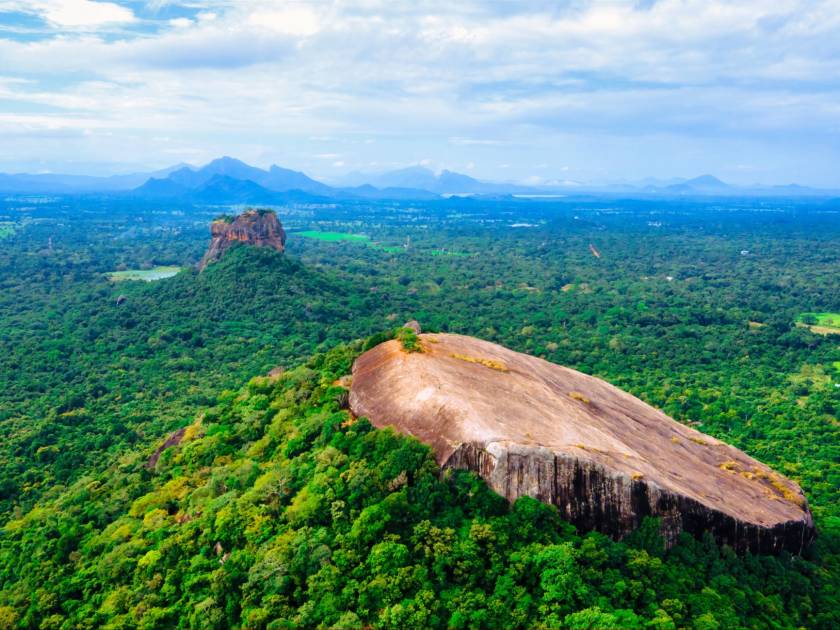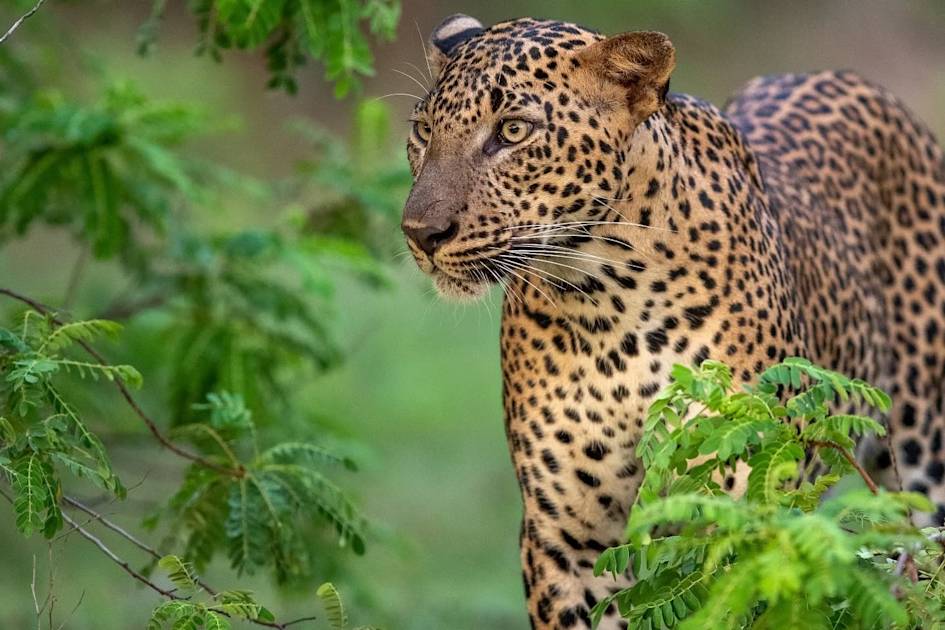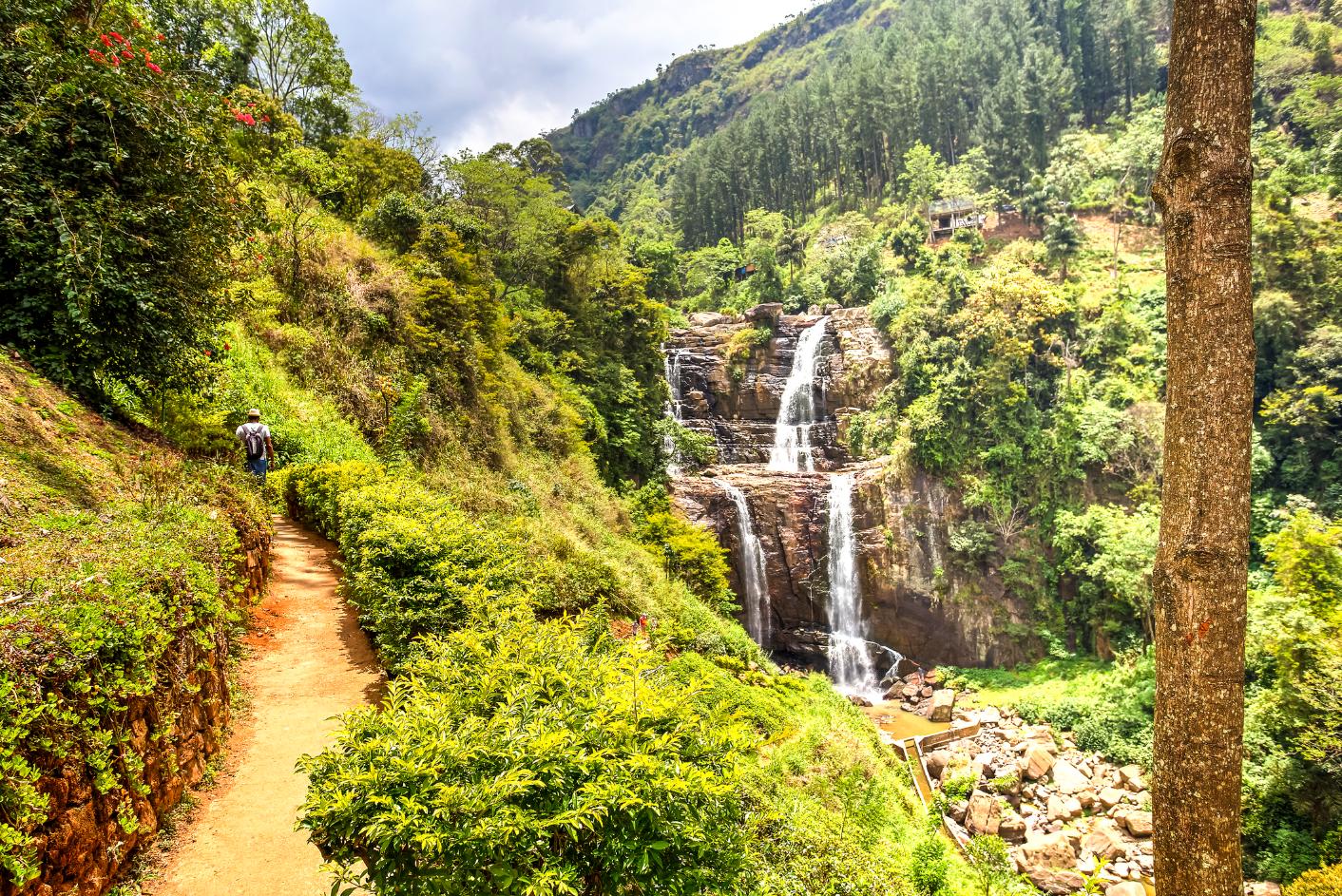Hiking in Sri Lanka is something which most travellers will have dreamed of at some point. Even just the name of the country conjures up images of lush, green rainforest, rolling mountains, tropical wildlife and turquoise water. The best hiking in Sri Lanka showcases that.
The country was named the “best country in the world” for travellers to visit back in 2019 by Lonely Planet. They cited its “rich and accessible wildlife” as well as the surf scene, culture and the friendliness of the people. More recently, Sri Lanka has become known as a hiking destination, and a new long distance trek through the highlands, the Pekoe Trail, has recently opened up.

This teardrop-shaped island is ringed with golden sand beaches and lagoons fringed with mangroves. Head inland in the south and central regions and you’ll find Sri Lanka’s highlands, consisting of high plateaus, cloud forests and the misty blue silhouettes of the Knuckles Mountains. This is also prime tea-growing territory, with steep slopes carpeted in emerald green tea plants. The best hiking in Sri Lanka showcases this diversity.
1. Lion Rock (Sigiriya)
2. Adam’s Peak (Sri Pada)
3. Monkey Mountain, Gal Oya
4. The Knuckles Five Peak Trail via Bambarella
5. The Pekoe Trail
Here’s our guide to the best hikes in Sri Lanka, what to eat and where to stay.

The Best Hikes in Sri Lanka, Mapped
These are the trailheads for our favourite Sri Lankan hikes, several of which are located in Sri Lanka's mountainous Central Highlands.
The Best Hikes in Sri Lanka
1. Lion Rock (Sigiriya)

- Start/Finish: Sigiriya (out and back)
- Distance: 3.1 miles (5km)
- Walking time: 2-3 hours
- Difficulty: Easy
- Best for: Hiking through history
Sigiriva is often described as Sri Lanka’s most famous viewpoint. The sight of Sigiriya, also known as Lion Rock, is one that adorns so many photographs of the country. What it’s tough to tell from the photographs though is that Sigiriya is actually also a fortress. The fortress was built by King Kashyapa way back in 477BC atop the rock, with a plateau halfway up the side of the rock providing a gateway in the shape of a lion.
The fortress was abandoned after King Kashyapa died (his successor apparently not having use for a giant rock fortress with a lion-shaped entrance), then used as a Buddhist monastery until the 14th century. It’s now a UNESCO World Heritage Site known as the eighth wonder of the world, and an important cultural landmark in the history of Sri Lanka.

Today, you can climb the 1,270 steps to see the well preserved ruins of Sigiriya. As you head to the base of the rock, you’ll climb stone steps up the boulder gardens with large rocks scattered across the sun-dappled grass - they were once the foundations of an ancient monastery, built around the third century BC. You’ll continue upwards through the Terraced Gardens, ascending up a vast brick stairway until you reach the Mirror Wall, which would have once been polished to a shine - it’s now marked with ancient graffiti.
From here, you’ll climb a narrow spiral metal staircase up to the Sigiriya Frescoes, depicting the women from King Kashyapa’s harem. Continue on upwards, climbing ever higher until you reach a narrow steel staircase embedded into the exposed rock, until you reach the summit. Here you’ll be able to explore the well-preserved ruins of the Sky Palace, and marvel over the views of the jungle below.
We’d recommend setting off early, before the sun gets too hot and the crowds arrive. You’ll have to pay an entry fee to Sigiriya (£28/$35), but there is an alternative. If you don’t want to go in, but just want to see it from afar, climb nearby Pidurangala Rock. From here, you can look back and see not just the rock, but the beautiful forests that surround it.
2. Adam’s Peak (Sri Pada)

- Start/Finish: Nallathanni (out and back)
- Distance: 7.4 miles (12km)
- Walking time: 5-6 hours
- Difficulty: Moderate
- Best for: Mountain pilgrimages
Adam’s Peak is a 2,243m (7,359 ft) high mountain in Central Sri Lanka, known for the Sri Pada or ‘sacred footprint’ rock formation near the summit. It’s an important pilgrimage destination for Buddhists, Hindus, Muslims and Christians, with thousands of pilgrims (and hikers) making the climb to the top every year.
There are four routes up the mountain. The most popular and frequently used route is the Hatton-Nallathanni Trail, which takes you up 5,500 stone steps to the summit. From Nallathanni Bridge, you’ll follow a path through a tea estate. At the end of the estate road, the first of the stone steps taking you up to the temple begin.
It’s a long, strenuous climb to the top, and the steps get especially steep as you draw closer to the summit. However, along the path are numerous tea shops and stalls, where you can stop for a break and a refreshment. You’ll find the trail fairly crowded, but part of the charm of this hike is rubbing shoulders with pilgrims of different faiths. We’d recommend starting early, at two or three in the morning, in order to reach the summit in time for sunrise. The view over the surrounding mountains is incredible.
3. Monkey Mountain, Gal Oya

- Start/Finish: Wild Camping Gal Oya (out and back)
- Distance: 4.3 miles (7km)
- Walking time: 3-4 hours
- Difficulty: Moderate
- Best for: Untouched trails
Gal Oya Valley National Park consists of dense forest surrounding the largest reservoir in Sri Lanka, Senanayake Samudraya. Off-limits during the Civil War, it has avoided development and is home to the indigenous Vedda people. It’s possible to take a guided hike through the forests of Gal Oya with one of the Vedda, learning about their culture and surrounding environment.
One trek you can take will take you to the summit of Monkey Mountain. Beginning at your accommodation, your Vedda naturalist guide will lead you through a small village with fields of crops, and into the forest. You’ll learn about different medicinal and edible plants as you climb upwards through dry forest and rough grassland littered with boulders. Monkey Mountain itself is a stony outcrop - it’s a steep climb to the top, and you may need to use your hands. Upon reaching the summit, you’ll be able to see across the forested hills of Gal Oya.
There is no clearly signposted trail here, and you’ll see precious few other hikers - which is very much this trek’s attraction.

4. The Knuckles Five Peak Trail via Bambarella

- Start/Finish: Dawatagala Knuckles Natural Trailhead (out and back)
- Distance: 5.97 miles (8km)
- Walking time: 5-6 hours
- Difficulty: Challenging
- Best for: Sri Lankan summit bagging
The trek heads deep into the rainforest and the rugged wilderness of the Knuckles Range, named due to their resemblance to a clenched fist. On this day hike, you’ll be summiting the Knuckles Five Peaks through steep trails up through dense forest.
Start hiking from the trailhead, off Knuckles Peak Road. You’ll proceed through scrubland until you reach a junction. You’ll need to turn to the right, but we recommend a quick detour to the left to see Knuckles Falls, a small cascading waterfall (which also makes for a refreshing shower on the way back). Continue along the trail towards a campsite, which is surrounded by the Knuckles Peaks. Follow the trail to a second campsite.

From here, the ascent becomes steeper and tougher, through forest with low hanging vines and branches. You’ll struggle upwards along a path of loose stones and soil towards the first peak. Due to the thick forest canopy, there’s no viewpoint here. However, the second peak has panoramic views of the surrounding tree-carpeted mountains. At 1,864m(6,115 ft), it’s the highest point on the trek.
To reach the remaining three peaks you’ll follow animal tracks along a ridge through the thick forest. The trail is barely visible in places, so be careful where you step. In these areas of dense forest, protection from leeches is a necessity.
5. The Pekoe Trail

- Start/Finish: Hanthana/ Nuwara Eliya (point to point)
- Distance: 186.4 mile (300km)
- Walking time: 22-25 days
- Difficulty: Challenging
- Best for: An immersive multi-day hike through Sri Lanka’s Highlands
The Pekoe Trail is a 300 km (186.4 mile) trekking route divided into 22 stages, taking you from the Hanthana Mountains near Kandy to the misty hill station of Nuwara Eliya. On the way, you’ll pass through a variety of landscapes, from aromatic montane forests to dramatic mountains like Adam's Peak.
The route takes its name from the tea estates it passes through, their undulating hills carpeted in emerald-coloured tea plants ('pekoe' refers to high quality black tea grown in Sri Lanka). You’ll pass through Loolkandura Estate, the first tea plantation in Sri Lanka, alongside old tea factories and colonial bungalows. You’ll hike along the railway tracks built by the British to transport tea, crossing the scenic Nine Arch Bridge, a vast viaduct surrounded by lush greenery.

Destination expert Viraj Fernando recommends trekking Stages 11 and 12 of the trail, which will take you through Horton Plains National Park, a biodiverse landscape of wild grasslands, cloud forest and mountains.
“It's a very Scottish type of landscape - mist-clad mountains and windy plateaus, very rich in flora,” he says. "There's a waterfall called Bakers Fall, which was founded by the British planter James Baker - it was named after him. There’s also a place called World’s End; it's a mountain cliff with a steep descent.”
The trail is now fully operational and signposted. However, due to its length and hiking through unfamiliar terrain, we’d always recommend you travel with a guide.
When is the Best Time to Hike in Sri Lanka?

It’s possible to hike in Sri Lanka year round, although peak season is considered to be between December and April. Temperatures remain fairly constant across the island, with average temperatures of 25-30°C in the coastal regions, and 15-18°C in the highlands.
However, it’s worth bearing in mind the two different monsoon seasons, in different parts of the country. The Maha (October to January) affects the northern and eastern areas, while the Yala (May to August) affects the south and western regions. The Central Highlands experience both monsoons, resulting in a cool, misty climate reminiscent of Scotland.
For hiking in the highlands, we’d recommend visiting between January and April, and for hiking in the Knuckles Mountains, we’d suggest going between February and April, or June to August (on either side of the Maha).
Most visitors to Sri Lanka will visit different parts of the island. This means you’re likely to experience a host of different weather conditions. Prepare for humidity, sunshine and sudden downpours.
What Animals Live in Sri Lanka?

A wide variety of wildlife lives in Sri Lanka’s diverse ecosystems. In the Central Highlands and the Knuckles Mountains, you’ll find endemic species such as the Sri Lankan leopard, the shaggy-coated toque macaque and the purple-faced langur. Sambar deer and barking deer graze in the grassy plains, while the forests are alive with vibrant bird species, including the Sri Lanka junglefowl and Layard’s parakeet.

Amphibians include endemic tree frogs and dwarf toads, while the oceans teem with marine life including sperm whales, orcas and spinner dolphins.
Where to Stay in Sri Lanka?

Across Sri Lanka, there’s a wide range of accommodation, from campsites to five star hotels. Responsible travellers will find numerous family-run guest houses and eco-lodges, where their tourism dollars benefit the local community. One example is Wild Glamping Gal Oya, built with the help of the local indigenous Vedda community using locally sourced materials and running on solar power. The majority of the hotel’s staff are from the local community.
If you’re going to be travelling within Sri Lanka’s Highlands, you can also stay on historic tea estates, in restored colonial bungalows built by the British.
What to Eat in Sri Lanka

Traditional Sri Lankan cuisine is a diverse fusion of local produce and South Indian flavours, alongside the culinary influences of Dutch and Portuguese colonists and Malay immigrants. Hoppers (a pancake made of coconut and rice flour) are popular breakfast foods, often served with egg and fresh coconut sambol; or you can have string hoppers (a noodle-style equivalent) with chicken or vegetable curry.
‘Rice and Curry’ is a popular staple - you’ll sit down to a steaming bowl of rice with a huge array of complementary dishes. These could include parippu, a spicy lentil dal, caramelised aubergine pickle (wambatu moju) and Ambul Thiyal, a sour fish curry. Meanwhile, lamprais is a Dutch-influenced dish of rice, beef meatballs, boiled eggs and whole spices, baked slowly in a banana leaf. For dessert, you could try wattalapam, a coconut milk custard sweetened with jaggery.
How to Get to (and Around) Sri Lanka

Most people fly into Bandaranaike International Airport (CMB), near the capital of Colombo, which has direct flights between cities in Asia, Europe, and the Middle East.
For travelling short distances, most people tend to grab a rickshaw or a taxi. You can also hire a taxi by the day over longer distances (your accommodation can help you with booking this). However, Sri Lanka also has an extensive railway network. Some of the journeys are particularly scenic, including the famous route through the highlands from Kandy to Ella.
FAQs

What are the best easy hikes in Sri Lanka?
The best easy hikes in Sri Lanka include Little Adam’s Peak—an easy 45-minute climb with panoramic views of tea plantations and the Ella Gap—and the Nine Arches Bridge walk, both near Ella. Other easy hikes include the gentle trails around Horton Plains National Park (like Mini World's End) and the Diyaluma Falls hike, which leads to Sri Lanka’s second highest waterfall.
What are the best hikes near Ella, Sri Lanka?
The most popular hikes near Ella include an ascent of Little Adam’s Peak, and Ella Rock, which offers up panoramic views of the surrounding hill country, including the iconic Nine Arches Bridge. The Pekoe Trail, Sri Lanka’s first long distance hike, also runs through Ella.
What is the best time of year to hike in Sri Lanka?
The best time to go hiking in Sri Lanka depends on the region. There are two monsoon seasons in Sri Lanka—the southwest monsoon from May to September, and the northeast monsoon from December to February. For the central and southern highlands (Ella, Nuwara Eliya, Horton Plains, Knuckles), the ideal season is December to April, when the weather is driest and visibility best.
How difficult is the Adam’s Peak (Sri Pada) climb?
The Adam’s Peak hike is a physically demanding but non-technical climb, involving over 5,000 stone steps to the summit at 2,243 m (7,359 ft). Most hikers begin the ascent around 2 am to reach the peak by sunrise. While no climbing experience is needed, the steep and repetitive steps can be tough on knees and calves. There are numerous coffee stalls along the way where you can stop for a break. Pilgrims of all ages complete the hike, so with steady pacing and breaks, it’s achievable for most reasonably fit visitors.
Do I need a guide to go hiking in Sri Lanka?
You don’t always need a guide for popular hikes in Sri Lanka, such as Lion’s Rock or Adam’s Peak. However, a guide is always recommended for remote or multi-day hikes in the central highlands, such as the Pekoe Trail. Guides can help you navigate unfamiliar terrain and can also offer insight into flora, fauna and local culture.
Inspired? Check out all our adventures in Sri Lanka.




